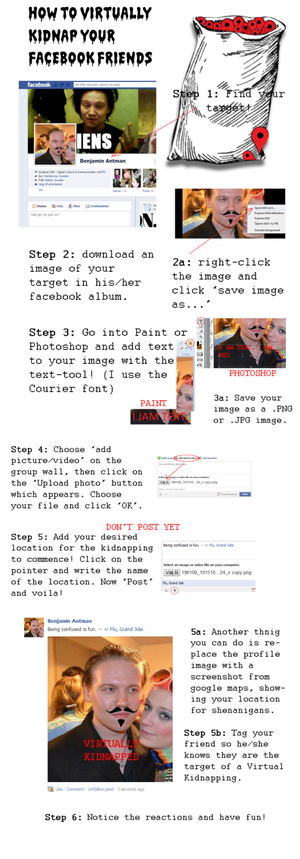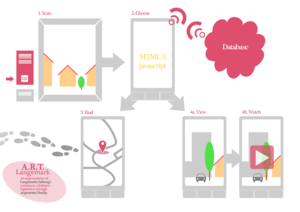Project text changes & Context: Difference between revisions
No edit summary |
No edit summary |
||
| (One intermediate revision by the same user not shown) | |||
| Line 13: | Line 13: | ||
Virtual Kidnapping was a project set on Facebook, it contained a group called “Virtual Kidnapper” where people would join to have their virtual locations on Facebook changed and played with. The project used the GPS-function on Facebook, and Google maps to automatically change the virtual positions of its participants. Each participant who joined had their profile image edited with the message “virtually kidnapped” or “Have you seen this person?” and pasted on the group’s wall. The virtual location of each image was then changed to signify that it had been taken ‘somewhere else’. The virtual kidnapper would then ask the participant to find material services on the web (Google f.ex) for how to live in the virtual location, or how the participant would get back to their original location. This was a project made for a summer school which questioned the significance of virtual location. To explore the material reactions imposed upon by changes in each participants location, and the following social interactions with facebook friends. The project sought to explore the virtual significance of kidnapping in the virtual sense, investigating the stigma of the material kind. The significance of the GPS or virtual map was questioned, stating that the social reaction to someone being virtually kidnapped would show our dependence on virtual locative media to signify our location and situation in the world. | Virtual Kidnapping was a project set on Facebook, it contained a group called “Virtual Kidnapper” where people would join to have their virtual locations on Facebook changed and played with. The project used the GPS-function on Facebook, and Google maps to automatically change the virtual positions of its participants. Each participant who joined had their profile image edited with the message “virtually kidnapped” or “Have you seen this person?” and pasted on the group’s wall. The virtual location of each image was then changed to signify that it had been taken ‘somewhere else’. The virtual kidnapper would then ask the participant to find material services on the web (Google f.ex) for how to live in the virtual location, or how the participant would get back to their original location. This was a project made for a summer school which questioned the significance of virtual location. To explore the material reactions imposed upon by changes in each participants location, and the following social interactions with facebook friends. The project sought to explore the virtual significance of kidnapping in the virtual sense, investigating the stigma of the material kind. The significance of the GPS or virtual map was questioned, stating that the social reaction to someone being virtually kidnapped would show our dependence on virtual locative media to signify our location and situation in the world. | ||
[[File: | [[File:VirtKid.png|thumbnail]] | ||
'''A.R.T Langemark''' | '''A.R.T Langemark''' | ||
| Line 19: | Line 19: | ||
The project consisted of a QR code stuck beside each painting, which linked to an individual webpage of each painting. Each webpage contained panoramic images of each location today where the painting in question was painted, a video showing how to get there by bike and also a google maps page showing each location. A.R.T Langemark is a project looking to situate itself in a permanent exhibition at the Art Hall of Karlskrona, Sweden, where a number of portraits of city environments from the 1960s have been painted by the artist Erik Langemark within Karlskrona. A.R.T Langemark was situated in the EXITART exhibition which was made prossible through our programme’s Project course. The purpose was to juxtapose today’s Karlskrona with historical Karlskrona, make it easier for interested tourists to find the locations where each painting was painted, and to show a direct approach to how to get there. Karlskrona enjoys calling itself a tourist town as a world heritage city but at times its history isn't presented well enough. The anonymous paintings in the art hall, made by a famous local artist, were given new importance once they gained a higher function as a window back in time. | The project consisted of a QR code stuck beside each painting, which linked to an individual webpage of each painting. Each webpage contained panoramic images of each location today where the painting in question was painted, a video showing how to get there by bike and also a google maps page showing each location. A.R.T Langemark is a project looking to situate itself in a permanent exhibition at the Art Hall of Karlskrona, Sweden, where a number of portraits of city environments from the 1960s have been painted by the artist Erik Langemark within Karlskrona. A.R.T Langemark was situated in the EXITART exhibition which was made prossible through our programme’s Project course. The purpose was to juxtapose today’s Karlskrona with historical Karlskrona, make it easier for interested tourists to find the locations where each painting was painted, and to show a direct approach to how to get there. Karlskrona enjoys calling itself a tourist town as a world heritage city but at times its history isn't presented well enough. The anonymous paintings in the art hall, made by a famous local artist, were given new importance once they gained a higher function as a window back in time. | ||
[[File:langemark.png|thumbnail]] | [[File:langemark.png|thumbnail|align:left]] | ||
Latest revision as of 15:59, 25 September 2014
This text has been changed to reflect the peer reviews of last week's assignment. This class' assignment will also discuss the larger cultural context of one of these works.
ICU – Imagined Letters
ICU is a HTML5 webpage which supports a parallax scrolling application, the project was done for a course which investigated the capability of e-literature. The project entailed a story ruled by 5 letters which each represented a word phonetically, giving a meaning to each interval and giving each letter the ability to form a story. Using javascript the site allow for objects to change places and disappear as the user scrolls. The webpage contained textual-, as well as graphical elements juxtaposing each other at certain intervals, so as to create a tension between text and image. As others presented works which included standardized book platforms my goal was The project entailed exploring the phonetical importance of individual letters. It was made as an attempt at reinventing the electronic book platform, as few sought to experiment with the e-book as a format. It was also an attempt at understanding the relation between HTML5/JavaScript and what potential it had to create a narrative, or disrupt one. One purpose was to question the format of the e-book, using non-standard platforms and ways of electronic expression.
'Cultural Context of ICU-Imagined letters'
The context of the project based itself mainly on the emergence of internet meme-culture, and the implications of decreasing book-literacy among youth according to Carr's 'The Shallows: What the Internet Is Doing to Our Brains'. The language of western society is, with the help of cultures like meme-culture, moving toward a language of symbols rather than letters. With this statement in mind I took a closer look at the symbols that make up language, the letters, and highlighted them by giving them a narrative and a meaning outside the formation of words, juxtaposing the letters as symbols.
Virtual Kidnapping
Virtual Kidnapping was a project set on Facebook, it contained a group called “Virtual Kidnapper” where people would join to have their virtual locations on Facebook changed and played with. The project used the GPS-function on Facebook, and Google maps to automatically change the virtual positions of its participants. Each participant who joined had their profile image edited with the message “virtually kidnapped” or “Have you seen this person?” and pasted on the group’s wall. The virtual location of each image was then changed to signify that it had been taken ‘somewhere else’. The virtual kidnapper would then ask the participant to find material services on the web (Google f.ex) for how to live in the virtual location, or how the participant would get back to their original location. This was a project made for a summer school which questioned the significance of virtual location. To explore the material reactions imposed upon by changes in each participants location, and the following social interactions with facebook friends. The project sought to explore the virtual significance of kidnapping in the virtual sense, investigating the stigma of the material kind. The significance of the GPS or virtual map was questioned, stating that the social reaction to someone being virtually kidnapped would show our dependence on virtual locative media to signify our location and situation in the world.
A.R.T Langemark
The project consisted of a QR code stuck beside each painting, which linked to an individual webpage of each painting. Each webpage contained panoramic images of each location today where the painting in question was painted, a video showing how to get there by bike and also a google maps page showing each location. A.R.T Langemark is a project looking to situate itself in a permanent exhibition at the Art Hall of Karlskrona, Sweden, where a number of portraits of city environments from the 1960s have been painted by the artist Erik Langemark within Karlskrona. A.R.T Langemark was situated in the EXITART exhibition which was made prossible through our programme’s Project course. The purpose was to juxtapose today’s Karlskrona with historical Karlskrona, make it easier for interested tourists to find the locations where each painting was painted, and to show a direct approach to how to get there. Karlskrona enjoys calling itself a tourist town as a world heritage city but at times its history isn't presented well enough. The anonymous paintings in the art hall, made by a famous local artist, were given new importance once they gained a higher function as a window back in time.


